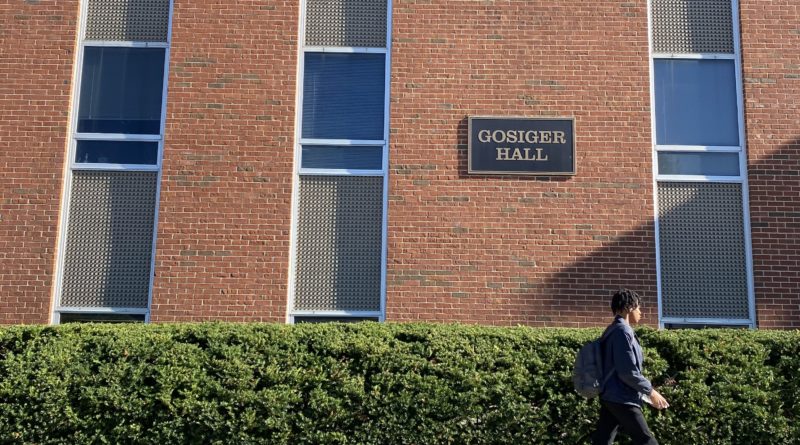‘Dayton Plague’ taunts students during COVID-19 pandemic
Photo of Gosiger Hall, home of UD’s student health center. Photo courtesy of Maddy Barsche, A&E Editor.
Alex DiMarco | Contributing Writer
It begins as a little lump when you swallow, but you assure yourself it’s just a scratch in your throat. The next morning you wake up and realize maybe it’s not just a scratch, but you take ibuprofen and make your way to class. A little sore throat is no reason to miss your 8 a.m., even if you wish it was.
The day goes on and your sore throat clears up a little. “Maybe it’s going away,” you begin to think. But as you return to your bedroom to get started on homework that night, you start to sniffle. Before you know it, you’ve gone through your whole tissue box — the same box you opened on the day you moved in a couple of months ago.
As soon as you lay down in bed your left nostril clogs completely and you have to breathe through your mouth to fall asleep. You don’t sleep very well that night, and the following day, as soon as your alarm goes off, you know you’re not making that 8 a.m. Not that day, and not the next.
Across the University of Dayton campus, a sickness has been spreading. Students have coined this illness the “Dayton Plague,” and nobody is safe. With various symptoms fluctuating from sore throat and congestion to high fever, fatigue and a raging cough, students across campus have been getting sick and finding themselves in recovery for an extended time.
“My first thought was that I had COVID,” sophomore Gregory Goldcamp said, remarking that his first symptoms were a cough followed by a sore throat.
Sophomore Bess Lehman had the same thought, prompting her to have her roommates test her using an over-the-counter COVID-19 test.
“I had a horrible sore throat, like the worst I’ve ever had,” Lehman said. “But I honestly think my roommates were more scared I had COVID than I was.”
According to the coronavirus student case dashboard on the UD’s website, the school has had 123 positive COVID-19 tests since Aug. 1. Though this may sound like a large number, keep in mind around this time last year there were reports of more than 100 new cases each day.
The Student Health Center has been keeping very busy since the semester started.
“A typical day last year brought in about 60 students for various reasons,” said Dr. Beth Shutte, lead staff physician at the on-campus health center. “This year we are seeing closer to 90 students per day. Most of the increase this year is due to non-COVID-related respiratory illnesses.”
When a patient comes in with potential COVID-19 symptoms, they are given a rapid 15-minute antigen test. If this test comes back negative, according to Shutte, the symptoms are likely caused by some other virus, some including RSV, rhinovirus, adenovirus, parainfluenza or influenza.
“We also routinely see strep throat and mono, which typically have a sore throat and possibly a fever without the congestion and cough,” added Shutte.
Though illness is no stranger on a college campus, it comes as quite a shock to students who haven’t seen regular non-COVID sickness in a long time.
“Almost all of my friends have gotten sick already,” Lehman said. “If you ask any student here whether they’ve gotten the plague this semester, I guarantee you’ll have a yes from 95% of them.”
Goldcamp and Shutte agree UD’s high vaccination rate and high rate of previous infection play a factor in why UD’s COVID-19 rates have stayed low and why common illnesses seem to be back on the rise.
“Everyone was so far away from people and public settings, so their immune systems got weaker because they weren’t exposed to illness,” Goldcamp said. “Now that we’re allowed to go out in public and gather again, germs are everywhere and everyone’s getting sick.”
Shutte agreed, adding, “We saw less of these common illnesses last year most likely due to social distancing, masking, and changes in behavior. This year, as more typical behaviors have returned, we are seeing the normal illnesses that have always been around.”
Although case numbers have been manageable thus far, the lead physician warns there are still many unknowns with COVID-19. Shutte provided some preventative measures students can take to protect themselves and those around them from COVID-19 and other illnesses:
- Get enough sleep. Most young adults need 7-9 hours a night. Lack of sleep doubles your risk of getting sick when exposed to cold germs.
- Eat a variety of healthy foods, emphasizing fruits, vegetables, and whole grains.
- Wash your hands or use a waterless hand sanitizer frequently.
- Keep your hands away from your eyes, nose and mouth. Many germs are picked up from doorknobs and transferred from our hands to our respiratory system by touching our faces.
For more campus news like Flyer News on Facebook and follow us on Twitter (@FlyerNews) and Instagram (@flyernews).

